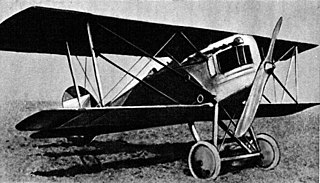| A.46 | |
|---|---|
| Role | Trainer |
| National origin | Czechoslovakia |
| Manufacturer | Aero |
| Number built | 1 |
The Aero A.46 was a Czechoslovakian military trainer biplane that flew in prototype form in 1931. No mass production resulted from Aero.
| A.46 | |
|---|---|
| Role | Trainer |
| National origin | Czechoslovakia |
| Manufacturer | Aero |
| Number built | 1 |
The Aero A.46 was a Czechoslovakian military trainer biplane that flew in prototype form in 1931. No mass production resulted from Aero.
General characteristics
Performance

The Aero A.12 was a Czechoslovakian biplane light bomber and military reconnaissance aircraft manufactured in small numbers shortly after World War I. Although reminiscent of the Hansa-Brandenburg-designed aircraft that Aero was building during the war under licence as the Ae.10, the A.12 was the company's own design. It is perhaps most significant as the direct descendant of the highly successful A.11 and its various derivatives. An example of the type is preserved at the Letecké Muzeum in Kbely.

The Aero A.18 was a biplane fighter aircraft built in Czechoslovakia in the 1920s. It was a development of the Ae 02 and Ae 04 fighters Aero had designed during World War I, but also borrowed from the more recent A.11 reconnaissance-bomber design.
The Aero A.25 was a biplane military trainer aircraft developed in Czechoslovakia from the Aero A.11 reconnaissance-bomber and generally similar to the Aero A.21 night trainer.

The Aero A.29 was a military biplane developed in Czechoslovakia from the ubiquitous Aero A.11 reconnaissance-bomber. Aero equipped it with floats and it served as a target tug for training anti-aircraft gunners.
The Aero A.26 was a Czechoslovakian military reconnaissance biplane aircraft built by Aero Vodochody in the 1920s. It was Aero's last design to be based on the Hansa-Brandenburg B.I aircraft that the company had been building under licence during World War I as the Ae.10.

The Aero A.34 Kos was a small sports and touring biplane built in Czechoslovakia in the 1930s.

The Aero A.35 was a Czechoslovakian airliner of the 1920s and 1930s. Designed by Aero for long-range flight, with a transatlantic crossing in mind, it saw service with CSA although no such crossing was ever attempted. A conventional high-wing monoplane, it was a very modern design for its day in all but one respect – the cockpit still had open sides. An extra passenger could also be accommodated here, beside the pilot.

The Aero A.38 was a Czechoslovakian biplane airliner of the 1920s and 1930s. Following the relatively modern A.35, this aircraft was something of a throwback, marrying a fuselage derived from the A.35 to wings copied from the A.23. A few served with CSA, and others with French airline Compagnie Internationale de Navigation Aérienne. These latter aircraft were powered by a French Gnome-Rhône engine instead.
The Aero A.104 was a parasol monoplane light bomber and reconnaissance aircraft built in Czechoslovakia during the 1930s. It was the final derivative of the Aero A.100, and was essentially an Aero Ab.101 with an enclosed cockpit and without the lower wing. Although two different prototypes flew in 1937, it was not mass-produced.

The Boeing XB-39 Superfortress was a United States prototype bomber aircraft, a single example of the B-29 Superfortress converted to fly with alternative powerplants. It was intended to demonstrate that the B-29 could still be put into service even if the first choice of engine, the air-cooled Wright R-3350 radial engine, ran into development or production difficulties.

The Focke-Wulf A 20 Habicht was an airliner developed in Germany in the late 1920s. It was a high-wing cantilever monoplane with fixed tailskid undercarriage. The fuselage was deep and seated four passengers in a fully enclosed cabin. The type was not bought by the airlines and only a few examples were built.
The Airdrome Dream Classic is a minimalist, high wing, single seat, single engine ultralight aircraft inspired by the 1908 Santos-Dumont Demoiselle and produced in kit form by Airdrome Aeroplanes of Holden, Missouri.

The Letov Š-8 was a Czech racing aircraft designed by Alois Šmolik. The aircraft was wooden-built, mostly fabric covered, with tail-skid undercarriage and was powered by a Napier Lion engine.
The Preceptor Stinger is an American homebuilt aircraft that was designed and produced by Preceptor Aircraft of Rutherfordton, North Carolina. When it was available the aircraft was supplied as plans or as a kit for amateur construction.
The Amax Vixen 105 is an Australian homebuilt aircraft that was designed and produced by Amax Engineering of Donvale, Victoria. When it was available the aircraft was supplied as a kit for amateur construction.

The Early Bird Jenny is an American homebuilt aircraft that was designed by Dennis Wiley and produced by the Early Bird Aircraft Company of Erie, Colorado, also by Leading Edge Airfoils of Peyton, Colorado. When it was available the aircraft was supplied as a kit and also in the form of plans for amateur construction.
The V-STOL XC 2000T is an American homebuilt and ultralight trainer aircraft that was designed and produced by V-STOL Aircraft of Fort Myers, Florida, introduced in the fall of 1997. When it was available the aircraft was supplied as a kit for amateur construction.
The V-STOL Super Solution 2000 is an American STOL homebuilt aircraft that was designed by Dick Turner and produced by V-STOL Aircraft Corporation of Fort Myers, Florida. When it was available the aircraft was supplied as a kit for amateur construction.
The Parascender Para-Ag is an American powered parachute agricultural aircraft that was designed and produced by Parascender Technologies of Kissimmee, Florida. Now out of production, when it was available the aircraft was supplied as a kit for amateur construction.
The Parascender II is an American powered parachute that was designed and produced by Parascender Technologies of Kissimmee, Florida. Now out of production, when it was available the aircraft was supplied as a kit for amateur construction.